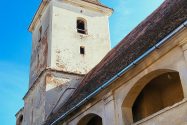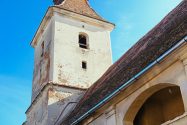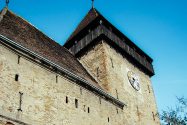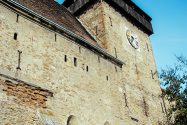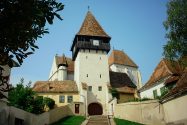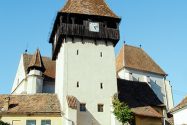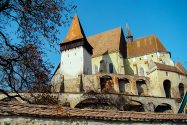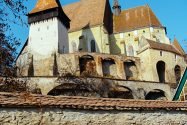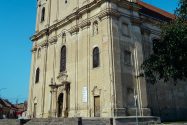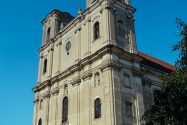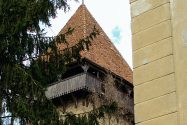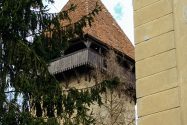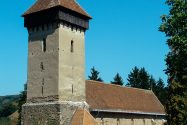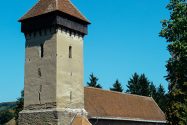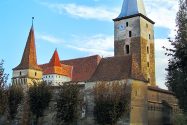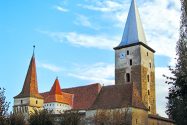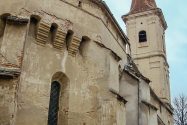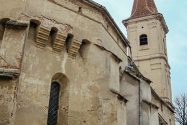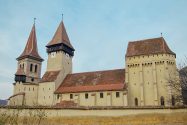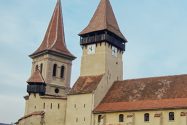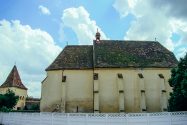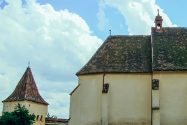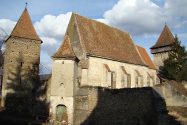
The surroundings of Medias
Agarbiciu
It is a locality that was part of the Seica Mare Seat (Schelk), being first mentioned in 1330 with the name Tychellrw. Traces of the Neolithic, bronze, iron and Roman period were found in this locality. The church-fortress appears first mentioned in 1415. The defense walls were added in 1502, having ramparts and gaps for firing.
Axente Sever
Known in antiquity under the name of “Villa Dominarium,” this is where a thesaurus was found with over 200 Imperial Roman coins made of silver, dating back to the 2nd to 3rd centuries AD, as well as a thesaurus of silver republican denars from 49 BC. Axente Sever was a free commune of the Medias Seat, under the name Frauendorf or Fraua, and in 1931 it has received the current name. The fortified church was built in the 13th century and is one of the few churches in Transylvania that have the bell tower above the choir.
Bazna
The Bazna commune is known especially for the chlorosodium mineral waters of the resort. It is one of the oldest settlements located in northern Sibiu County, being documented in 1270. In 1359, it was a free commune of the Medias Seat.
Saltwater treatment is made in Bazna, which is especially recommended for people suffering from disease of the locomotor system, rheumatism, diseases of the peripheral nervous system or chronic diseases of the respiratory system. The water has a very high salt concentration of 300 grams/liter. Also, in the village of Boian, you can visit the Gothic-style evangelical church that was built in 1402.
Biertan
Here is one of the most impressive churches in Transylvania, which was included in the UNESCO heritage. The fortress has four rows of walls and nine towers and bastions, being the strongest fortification in the rural areas of the Tarnavelor Valley. The church dates back to 1402, and its location and strong fortifications have played an important role in the defensive system of medieval Transylvania.
Cetatea de Balta
The fortress in the locality is one of the oldest fortifications in Transylvania, mentioned in documents from 1202-1203. From the old wooden fortifications and the waves of earth that surrounded the church, only portions of the defense ditch remained. The church was rebuilt in the 16th century, and the castle, known as the Bethlen-Haller Castle, is a copy of Chambord Castle.
Dumbraveni
The town of Dumbraveni has been documented since 1332, being known as Ebesfalva, Ebesdorf or Ibasfalau. One of the most important tourist attractions in Dumbraveni is the beautiful Saint Elizabeth Armenian-Catholic Church. Also in Dumbraveni, the Apafi Castle, built in 1552 by the noble family with the same name, can be visited. It is possible to notice influences from the regions of Moldova and Oltenia regarding the structure of the rooms, but unfortunately the mural paintings have not been preserved. In the past, inside the castle was the city hall, but it was also used as a space for army and imprisonment.The Roman Catholic Church is a single-tower hall that was built in 1795-1798.
Mosna
In the past, it was one of the three major localities of the Two Seats, alongside Biertan and Medias. In 1495, Mosna obtained the right to organize a trade fair and have their own craftsmen guilds, but these were controlled by the guilds from Medias. The fortified church of Mosna was built by the stone craftsman Andreas Lapicida from Sibiu. It is built in the late Gothic style, and the fortifications include an observation tower, two towers of defense, two bastions, and the wall of the fortress, 9 m thick.
Seica Mare
Seica Mare was mentioned in 1309 and then as the residence of the Schelk Seat in 1336. A Romanic basilica with early Gothic influences was built in 1300. Two Romanesque windows, the crossed vault of the choir and the triumphal arch have been preserved. Its fortification took place in the 15th century. The fortified church had 8 m walls, ramparts and a guard road. The fortifications were demolished in 1906, leaving only a short wall.
The Buia Castle (Bolyai) from the village of the same name, belonging to the commune of Seica Mare, was built by a noble family, Bolyai, and it is mentioned for the first time in 1324. It had 12 rooms, a courtyard with round stone tables and a cellar. After the battle of Selimbar in 1599, the castle was donated by Sigismund Báthory to Mihai Viteazul. In the past, the castle functioned as a dispensary and warehouse, and today only its ruins remain.
Seica Mica
The Gothic Church from Seica Mica was built from quarry stone in the 15th century, and then it was fortified. In the sixteenth century, the fountain was built, which had the purpose of uniting the bell tower with the gate tower. Its elements of construction are unique in Transylvania, being a very difficult fortress to conquer. The fountain church and courtyard were kept intact. One of the most valuable objects in the patrimony of the church is the bronze crown, made by the craftsman from Sibiu, Leonhardus, in 1477.
